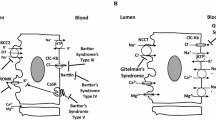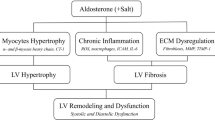Abstract
Background/aims: While Angiotensin II (Ang II) is a major factor in the development of cardiomyocyte hypertrophy and a pivotal role for Ang II signals via ERK1/2 has been identified, mechanism(s) responsible are still unclear. As Bartter’s and Gitelman’s syndrome patients (BS/GS) have increased Ang II, and yet normo/hypotension, hyporesponsiveness to pressors and blunted Ang II signaling via type 1 receptors (AT1R), this study assesses BS/GS’s left ventricular (LV) mass and structure as well as Ang II induced ERK1/2 phosphorylation compared with essential hypertensive patients (EH) and normotensive healthy subjects (C) to gain insight into Ang II mediated processes. Methods: Indices of cardiac hypertrophy were determined by M-mode, two-dimensional echo Doppler and ERK phosphorylation by Western blot. Results: None of BS/GS exhibited LV remodelling; LV mass, LV end-diastolic volume and mass/volume ratio were unchanged vs C (60±14 g/m2 vs 64±12, 64±12 ml/m2 vs 60±8 and 0.95±0.2 vs 1.0±0.2, respectively) and reduced vs EH (119±15, p<0.001, 78±9, p<0.05 and 1.52±0.15, p<0.01). Despite BS/GS’s higher plasma renin activity and aldosterone and unchanged level of AT1R, Ang II induced ERK1/2 phosphorylation was reduced vs both C and EH: 0.64 d.u.±0.08 vs 0.90±0.06 in C, p<0.006, and vs 1.45±0.07 in EH, p<0.001. Conclusion: The data point to a direct cardioremodeling role for Ang II and support a role of Ang II type 2 receptor (AT2R) signaling as involved in the lack of cardiovascular remodeling in BS/GS. However, further studies using more direct approaches to demonstrate the effects of AT2R signaling must be pursued.
Similar content being viewed by others
References
Levy D, Garrison RJ, Savage DD, Kannel WB, Castelli WP. Prognostic implications of echocardiographically determined left ventricular mass in the Framingham Heart Study. N Engl J Med 1990, 322: 1561–6.
Gosse P. Left ventricular hypertrophy as a predictor of cardiovascular risk. J Hypertens Suppl 2005, 23: S27–33.
Mehta PK, Griendling KK. Angiotensin II Cell Signaling. Physiological and Pathological Effects in the Cardiovascular System. Am J Physiol Cell Physiol 2007, 92: C82–97.
Devereux RB, Dahlöf B, Gerdts E, et al. Regression of hypertensive left ventricular hypertrophy by losartan compared with atenolol. The Losartan Intervention for Endpoint Reduction in Hypertension (LIFE) Trial. Circulation 2004, 110: 1456–62.
Schmieder RE, Martus P, and Klingbeil A. Reversal of left ventricular hypertrophy in essential hypertension. A meta analysis of randomized double-blind studies. JAMA 1996, 275: 1507–13.
Naesens M, Steels P, Verberckmoes R, Vanrenterghem Y, Kuypers D. Bartter’s and Gitelman’s syndromes: from gene to clinic. Nephron Physiol 2004, 96: 65–78.
Calò LA. Vascular tone control in humans: the utility of studies in Bartter’s/Gitelman’s syndromes. Kidney Int 2006, 69: 963–6.
Calò LA, Pessina AC. RhoA/Rho-kinase pathway: much more than just a modulation of vascular tone. Evidence from studies in humans. J Hypertens 2007, 25: 259–64.
Calò LA, Puato M, Schiavo S, et al. Absence of vascular remodeling in a high angiotensin II state (Bartter’s and Gitelman’s syndromes). Implications for angiotensin II signaling pathways. Nephrol Dial Transplant 2008, 23: 2804–9.
O’Regan S, Heitz F, Davignon A. Echocardiography assessment of left ventricular function in patients with hypokalemia. Miner Electrolyte Metab 1985, 11: 1–4.
Calò L, Scognamiglio R, Nistri S, et al. Evidence of myocardial dysfunction in Bartter’s syndrome. Am J Nephrol 1997, 17: 124–7.
Foglia PE, Bettinelli A, Tosetto C, et al. Cardiac work up in primary renal hypokalaemia-hypomagnesaemia (Gitelman syndrome). Nephrol Dial Transplant 2004, 19: 1398–402.
Calo LA, Pagnin E, Davis PA, et al. Increased Expression of Regulator of G Protein Signaling-2 (RGS-2) in Bartter’s/Gitelman’s Sydrome. A Role in the Control of Vascular Tone and Implication for Hypertension. J Clin Endocrinol Metab 2004, 89: 4153–7.
Calò LA, Pagnin E, Ceolotto G, et al. Silencing regulator of G protein signaling-2 (RGS-2) increases angiotensin II signaling: insights into hypertension from findings in Bartter’s/Gitelman’s syndromes. J Hypertens 2008, 26: 938–45.
Schiller NB, Shah PM, Crawford M, et al. Recommendations for quantitation of the left ventricle by two-dimensional echocardiography. American Society of Echocardiography Committee on Standards, Subcommittee on Quantitation of Two-Dimensional Echocardiograms. J Am Soc Echocardiogr 1989, 2: 358–67.
Devereux RB, Alonso DR, Lutas EM, et al. Echocardiographic assessment of left ventricular hypertrophy: comparison to necropsy findings. Am J Cardiol 1986, 57: 450–8.
Dzau VJ and Lopez-Ilasaca M. Searching for transcriptional regulators of Ang II-induced vascular pathology. J Clin Invest 2005, 115: 2319–22.
Zhan Y, Brown C, Maynard E, et al. Ets-1 is a critical regulator of Ang II-mediated vascular inflammation and remodeling. J Clin Invest 2005, 115: 2508–16.
Calò LA, Pagnin E, Davis PA, Sartori M, Semplicini A. Oxidative stress related factors in Bartter’s and Gitelman’s syndromes: relevance for Angiotensin II signalling. Nephrol Dial Transplant 2003, 18: 1518–25.
Calò L, Ceolotto G, Milani M, et al. Abnormalities of Gq-mediated cell signaling in Bartter and Gitelman syndromes. Kidney Int 2001, 60: 882–9.
Calo L, Davis PA, Semplicini A. Reduced content of alpha subunit of Gq protein in monocytes of Bartter and Gitelman syndromes: Relationship with vascular hyporeactivity. Kidney Int 2002, 61: 353–4.
Wieland T, Lutz S, Chidiac P. Regulators of G protein signaling: a spotlight on emerging functions in the cardiovascular system. Curr Opin Pharmacol 2007, 7: 1–7.
Le TH, Coffman TM. RGS2. A “turn-off” in hypertension. J Clin Invest 2003, 111: 441–3.
Semplicini A, Lenzini L, Sartori M, et al. Reduced expression of regulator of G protein signaling-2 in hypertensive patients increases calcium mobilization and ERK1/2 phosphorylation induced by angiotensin II. J Hypertens 2006, 24: 1115–24.
Volpe M, Musumeci B, De Paolis P, Savoia C, Morganti A. Angiotensin II AT2 receptor subtype: an uprising frontier in cardiovascular diseases? J Hypertens 2003, 21: 1429–43.
Hansen JL, Servant G, Baranski TJ, Fujita T, Iiri T, Sheikh SP. Functional reconstitution of the angiotensin II type 2 receptor and Gi activation. Circ Res 2000, 87: 753–9.
Abadir PM, Periasamy A, Carey RM, Siragy HM. Angiotensin II type 2 receptor bradykinin B2 receptor functional heterodimerization. Hypertension 2006, 48: 316–22.
Calo L, Davis PA, Milani M, et al. Increased endothelial nitric oxide synthase mRNA level in Bartter’s and Gitelman’s syndrome. Relationship to vascular reactivity. Clin Nephrol 1999, 51: 12–7.
Calo L, D’Angelo A, Cantaro S, et al. Increased urinary NO2-/NO3- and cyclic GMP levels in patients with Bartter’s syndrome: relationship to vascular reactivity. Am J Kidney Dis 1996, 27: 874–9.
Pagnin E, Davis PA, Sartori M, Semplicini A, Pessina AC, Calo LA. Rho kinase and PAI-1 in Bartter’s/Gitelman’s syndromes: relationship to angiotensin II signaling. J Hypertens 2004, 22: 1963–9.
Pagnin E, Semplicini A, Sartori M, Pessina AC, Calo LA. Reduced mRNA and protein content of Rho guanine nucleotide exchange factor (RhoGEF) in Bartter’s and Gitelman’s syndromes. Relevance for the pathophysiology of hypertension. Am J Hypertens 2005, 18: 1200–5.
Savoia C, Tabet F, Yao G, Schiffrin E, Touyz R. Negative regulation of Rho/Rho kinase by angiotensin II type 2 receptor in vascular smooth muscle cells: role in angiotensin II-induced vasodilation in stroke-prone spontaneously hypertensive rats. J Hypertens 2005, 23: 1037–45.
Kurisu S, Ozono R, Oshima T, et al. Cardiac angiotensin II type 2 receptor activates the kinin/NO system and inhibits fibrosis. Hypertension 2003, 41: 99–107.
Author information
Authors and Affiliations
Corresponding author
Rights and permissions
About this article
Cite this article
Calò, L.A., Montisci, R., Scognamiglio, R. et al. High angiotensin II state without cardiac remodeling (Bartter’s and Gitelman’s syndromes): Are angiotensin II type 2 receptors involved?. J Endocrinol Invest 32, 832–836 (2009). https://doi.org/10.1007/BF03345754
Accepted:
Published:
Issue Date:
DOI: https://doi.org/10.1007/BF03345754




